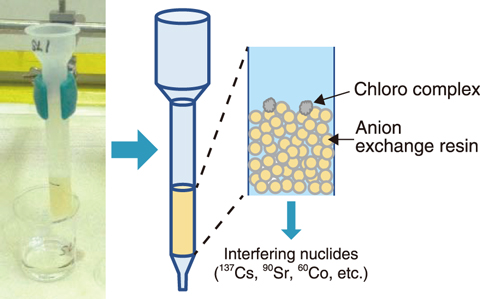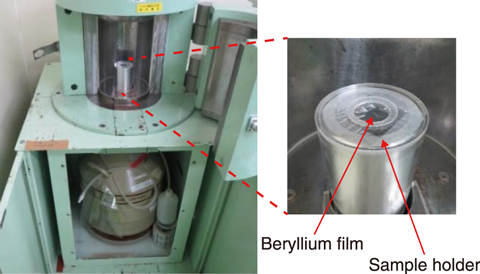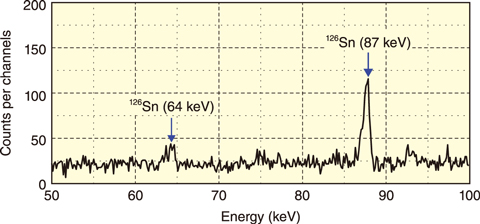
Fig.1-19 Separation of interfering nuclides using an anion exchange resin

Fig.1-20 Planar high purity germanium low-energy photon spectrometer (Ge-LEPS)

Fig.1-21 126Sn measurement spectrum using Ge-LEPS
The establishment of waste disposal policies including future waste such as rubble is urgent for proper decommissioning of the TEPCO’s Fukushima Daiichi NPS (1F). As such, radioactivity data must be collected, and new analytical methods must be established for nuclides which the analytical methods have not been determined. Analytical methods simple enough to apply during routine analysis for four such nuclides were thus developed: zirconium-93 (93Zr), molybdenum-93 (93Mo), palladium-107 (107Pd), and tin-126 (126Sn).
Among these, the analytical method for 126Sn is discussed here as an example. A hydrogen peroxide pretreatment was first used to ensure the presence of only tetravalent Sn, as Sn coexists as divalent and tetravalent ions. In a hydrochloric acid solution, Sn forms a chloro complex (i.e., a complex with a chloride ion), becoming an anion that can then be adsorbed on an anion-exchange resin (Fig.1-19) and separated from interfering nuclides that do not become anions, such as cesium-137 (137Cs) and strontium-90 (90Sr), which emit beta rays and raise the background by bremsstrahlung.
The gamma rays were then measured using a planar high-purity germanium low-energy photon spectrometer (Ge-LEPS) (Figs.1-20 and 1-21).
93Zr and 93Mo were adsorbed to a solid-phase extraction agent (TEVA resin) using a weak concentration of hydrofluoric acid, eluted with a high concentration of hydrofluoric acid and hydrochloric acid, and then quantified by mass spectrometry or radiation measurement. 107Pd was adsorbed to an anion exchange resin using a hydrochloric acid, eluted with ammonia water to efficiently separate from interfering nuclides, and then quantified by mass spectrometry.
The accuracy of the developed analytical method was confirmed using contaminated water collected from 1F. Furthermore, a worker-friendly analysis manual incorporating a check sheet was developed for routine analysis of radionuclides, which is expected to assist the accelerated establishment of disposal policies involving the collecting and accumulating a large amount of radioactivity data when radiochemical analysis is started at the Okuma Analysis and Research Center.
This work was supported by the Subsidy Project of Decommissioning and Contaminated Water Management by the Agency for Natural Resources (ANRE), the Ministry of Economy, Trade and Industry (METI), Japan.